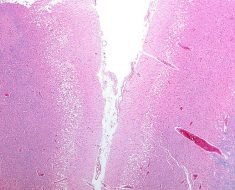According to the Deutsche Multiple Sklerose Gesellschaft (German Multiple Sclerosis Society), around 200,000 people in Germany suffer from multiple sclerosis (MS), a serious neurological condition that has no known cure. Although the causes are unknown, researchers do know that the the immune system erroneously attacks the protective sheaths around nerve fibres. In conjunction with researchers from Münster, Germany, a team of scientists at Friedrich-Alexander-Universität Erlangen-Nürnberg (FAU) led by Prof. Dr. Michael Wegner have now discovered how the formation of myelin sheaths is regulated by protein molecules. This knowledge could be used to stimulate the formation of new myelin sheaths after a relapse.
The human brain is likened to a high-performance computer in which it’s essential for the numerous individual processors to be connected to each other as efficiently as possible using high-speed cables. Each of the between 90 and 100 billion nerve cells represent the processors, and the nerve fibres or axons covered by myelin sheaths represent the fibre optic cables. The speed at which information is transmitted is highly dependent on the quality of the myelin sheaths, which are formed by special brain cells called oligodendrocytes. Damage to myelin sheaths or to the cells from which they are produced leads to serious disorders such as MS. Such disorders finally lead to the nerve cells being destroyed.
Complex mechanisms regulate myelin formation
The working group led by Prof. Dr. Michael Wegner, Chair of Biochemistry and Pathobiochemistry at FAU, is researching how oligodendrocytes regulate the formation of myelin sheaths. Neurological disorders such as MS can only be understood with this knowledge. The working group has already identified protein molecules such as Sox10 that regulate the formation and preservation of myelin sheaths.
The aim of the new project was to understand how the identified proteins interact when myelin is formed. The researchers discovered that other molecules called Nfat proteins are required for this interaction between the known molecules to be successful. These are mainly known for their function in the immune system. The presence of Nfat proteins in the oligodendrocytes ensures that all other required protein molecules can exist together in these cells without displacing each other.
In their work, which has recently been published in Nature Communications, Prof. Dr. Wegner’s working group led by Dr. Matthias Weider and Prof. Dr. Tanja Kuhlmann’s team from Universitätsklinikum Münster demonstrated the precise biochemical mechanisms involved. Inhibition of Nfat proteins adversely affects the capability of oligondendrocytes in rats, mice and also humans to form myelin. There are in fact fewer of these proteins in oligondendrocytes in parts of the brain affected by MS. However, it is still unclear whether this is one of the causes of the damage. “The interrelationships are very complex,” says Michael Wegner.
The findings are not only relevant to basic research, but also to medicine. Targeted stimulation of Nfat proteins could perhaps be used in the future to promote the formation of new myelin sheaths in MS patients, for example after a relapse. However, such stimulating substances are not yet available. Up to now, only substances that inhibit the activity of Nfat proteins have been developed, such as Cyclosporin A and Tacrolimus. They are used in medicine mainly to keep the immune system under control and thus prevent organ rejection in transplant patients, for example. An interesting fact is that these patients often suffer from neurological disorders that are caused by myelin sheath loss. The new research suggest that these serious side effects are a direct result of the medication to inhibit Nfat proteins. It is thus extremely important that this medication is improved.
Source: Read Full Article





